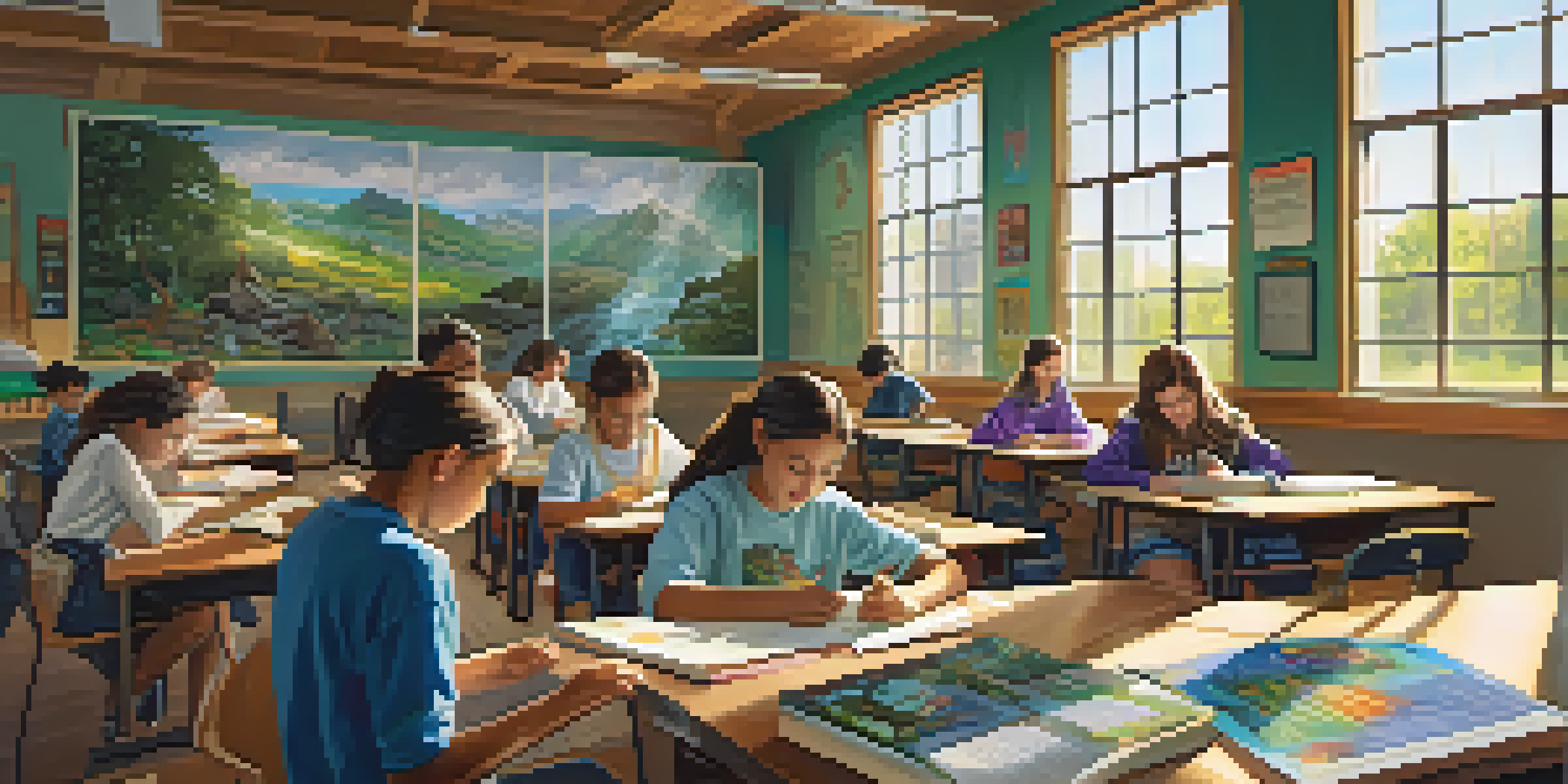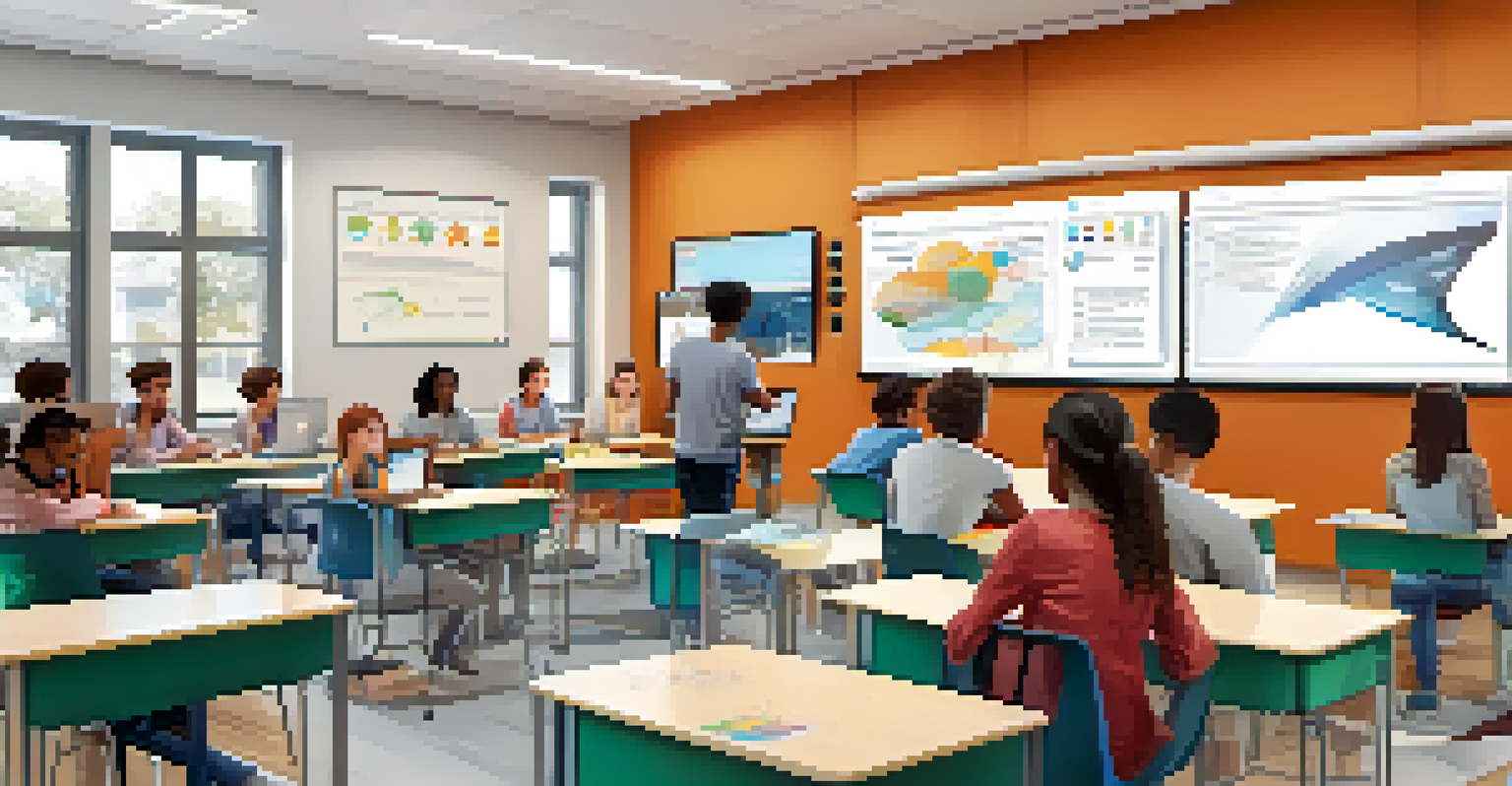Strategies for Implementing Constructivist Learning in Class

Understanding Constructivist Learning Principles
Constructivist learning is grounded in the belief that knowledge is constructed through experience. This means students build their understanding by connecting new information to their existing knowledge. For instance, when a student learns about ecosystems, they might relate it to their own backyard, making the lesson more relevant and impactful.
The mind is not a vessel to be filled, but a fire to be kindled.
By focusing on experiences rather than rote memorization, educators can foster deeper comprehension. This approach encourages critical thinking and problem-solving skills, as students are actively engaged in their learning process. They learn to ask questions, seek answers, and reflect on their findings.
Ultimately, understanding these principles is the first step toward implementing them in the classroom. Teachers who grasp the essence of constructivism can more effectively create an environment that prioritizes exploration and inquiry.
Creating a Collaborative Classroom Environment
Collaboration is a cornerstone of constructivist learning. When students work together on projects or discussions, they exchange ideas, challenge each other’s thinking, and build a richer understanding of the subject matter. For example, group projects can foster teamwork and reinforce the idea that learning is a shared journey.

In a collaborative environment, teachers can act as facilitators rather than traditional instructors. This shift allows students to take on more responsibility for their learning, promoting autonomy and engagement. Small group discussions can spark creativity and innovation as students share diverse perspectives.
Constructivist Learning Basics
Constructivist learning emphasizes that knowledge is built through experiences and connections to prior knowledge.
Moreover, establishing a culture of collaboration helps students develop essential social skills. They learn to communicate effectively, respect different viewpoints, and negotiate differences—all vital skills for their future endeavors.
Encouraging Inquiry-Based Learning
Inquiry-based learning invites students to ask questions and explore topics that intrigue them. This method empowers students to take charge of their learning, leading to greater motivation and investment in their education. For instance, rather than simply lecturing about historical events, a teacher might encourage students to investigate the causes and effects of a specific event.
Tell me and I forget. Teach me and I remember. Involve me and I learn.
This approach not only promotes critical thinking but also highlights the importance of research and evidence. Students learn to formulate hypotheses, gather information, and draw conclusions, essentially acting like mini-scientists in their classrooms. By engaging in this process, they develop a deeper understanding of the subject matter.
Additionally, inquiry-based learning can be tailored to students' interests, making lessons more relevant and engaging. When students are genuinely curious about a topic, they are more likely to retain information and apply it in real-world situations.
Utilizing Real-World Connections in Lessons
Connecting classroom learning to real-world scenarios can significantly enhance student engagement. When students see the relevance of what they’re learning, they are more likely to retain information and apply it outside the classroom. For example, math lessons can incorporate budgeting for a school event, linking abstract concepts to practical applications.
These real-world connections can also lead to deeper discussions and critical thinking. Students might explore how historical events shape modern society or how scientific advancements impact their daily lives. Such discussions encourage them to think beyond textbooks and engage with the world around them.
Collaboration Enhances Learning
Creating a collaborative classroom environment fosters teamwork and allows students to take responsibility for their learning.
Moreover, these connections can help students develop a sense of purpose in their learning. When they understand how their education relates to their lives and future careers, they are more motivated to succeed.
Incorporating Technology to Enhance Learning
In today’s digital age, technology can be a powerful tool for constructivist learning. It allows students to explore and create in ways that were previously unimaginable. For instance, using virtual simulations can help students understand complex scientific concepts, making learning both interactive and engaging.
Moreover, technology can facilitate collaboration among students, even beyond the classroom. Online discussion forums or collaborative documents enable students to work together on projects, share ideas, and provide feedback in real time. This not only enhances their learning experience but also prepares them for a technology-driven world.
However, it's essential to integrate technology thoughtfully. Teachers should ensure that it supports the learning objectives and encourages active engagement rather than passive consumption of information.
Fostering a Growth Mindset in Students
A growth mindset is the belief that abilities and intelligence can be developed through dedication and hard work. Encouraging this mindset in students can transform their approach to learning and challenges. For example, praising effort rather than innate ability helps students understand that persistence is key to success.
When students adopt a growth mindset, they are more likely to embrace challenges, learn from feedback, and persist in the face of setbacks. This resilience is crucial in a constructivist learning environment, where exploration and experimentation often lead to mistakes. By framing mistakes as learning opportunities, educators help students view failure as a stepping stone to success.
Real-World Connections Matter
Linking classroom lessons to real-world scenarios boosts student engagement and helps them see the relevance of their education.
Creating a culture that values effort and resilience can significantly enhance student motivation. When they believe in their capacity to grow, they are more likely to engage deeply with their learning experiences.
Assessing Understanding Through Authentic Assessment
Authentic assessment focuses on evaluating students’ understanding through real-world tasks rather than traditional testing methods. This approach aligns perfectly with constructivist principles, as it emphasizes practical application of knowledge. For instance, instead of a multiple-choice quiz, students might create a project that demonstrates their understanding of a topic.
Such assessments allow for a more comprehensive evaluation of student learning. They can showcase not only what students know but also how they apply that knowledge creatively and critically. This method encourages students to take ownership of their learning and express their understanding in diverse ways.

Moreover, authentic assessments can be more motivating for students. When they see the relevance of their work and receive feedback that helps them grow, they are more likely to remain engaged and invested in their education.